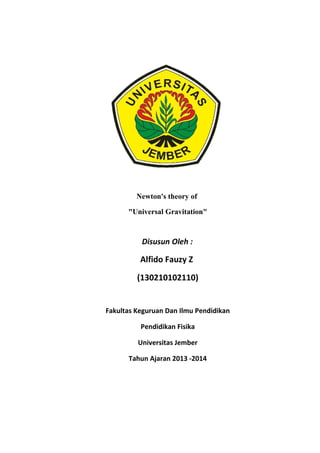
Hukum Newton Gravitasi
- 1. Newton's theory of "Universal Gravitation" Disusun Oleh : Alfido Fauzy Z (130210102110) Fakultas Keguruan Dan Ilmu Pendidikan Pendidikan Fisika Universitas Jember Tahun Ajaran 2013 -2014
- 2. Newton's theory of "Universal Gravitation" Sir Isaac Newton was an mathematician and physicist who lived from 1642-1727.The legend is that Newton discovered Gravity when he saw a falling apple while thinking about the forces of nature. Whatever really happened, Newton realized that some force must be acting on falling objects like apples because otherwise they would not start moving from rest. Newton also realized that the moon would fly off away from Earth in a straight line tangent to its orbit if some force was not causing it to fall toward the Earth. The moon is only a projectile circling around the Earth under the attraction of Gravity. Newton called this force "gravity" and determined that gravitational forces exist between all objects. Gravity is a force of attraction that exists between any two objects. There is a force of gravity between the sun and the Earth, between the Earth and us, and even between two marbles. Projectiles, satellites, planets, galaxies, and clusters of galaxies are all influenced by Gravity.Gravity is the weakest of the four known
- 3. forces of nature, yet the most dominant force. Even though it's the weakest force, Gravity holds together entire solar systems and galaxies. The law of universal gravitation says that every object attracts every other object with a force that, for any two objects, is directly proportional to the mass of each object and inversely proportional to the square of the distance between the two objects. Source : http://www.stanford.edu/~buzzt/gravity.html The Formula for the Force of Gravity Newton rightly saw this as a confirmation of the "inverse square law". He proposed that a "universal" force of gravitation F existed between any two masses m and M, directed from each to the other, proportional to each of them and inversely proportional to the square of their separation distance r. In a formula (ignoring for now the vector character of the force): Suppose M is the mass of the Earth, R its radius and m is the mass of some falling object near the Earth's surface. Then one may write From this
- 4. The capital G is known as the constant of universal gravitation. That is the number we need to know in order to calculate the gravitational attraction between, say, two spheres of 1 kilogram each. Unlike the attraction of the Earth, which has a huge mass M, such a force is quite small, and the number G is likewise very, very small. Measuring that small force in the lab is a delicate and difficult feat. Source : http://www.phy6.org/stargaze/Sgravity.htm Exercise : What is the gravitational force that the sun exerts on the earth? The earth on the sun? In what direction do these act? ( G= 6,67×10-11 Nm2/kg2 , Me = 5.98×1024kg, M s = 1.99×1030kg and the earth-sun distance is 150×109 meters). First, consider the directions. The force acts along the direction such that it attracts each body radially along a line towards their common center of mass. For most practical purposes, this means a line connecting the center of the sun to the center of the earth. The magnitude of both forces is the same, as we would expect from Newton's Third Law, and they act in opposite directions, both attracting each other mutually. The magnitude is given by:
- 5. Application of Newton's theory of Universal Gravitation : 1. Calculate the mass of the Earth The mass of the Earth can be calculated using the G values have been obtained from the Cavendish experiment. Think of the Earth's mass M and radius R = 6.37 × earth 106 m (earth considered perfectly round). Based on the formula of the earth's gravitational acceleration, we can calculate the mass of the earth. 2. Calculate the mass of the Sun We know that the radius of Earth's orbit mean rB = 1.5 × 10 11 m and the period of the earth around the sun TB = 1 year = 3 × 10 7 s. Based on these, we can be estimated mass of the sun. 3. Calculating speed of satellite Satelite is an object that surronding another object which has larger mass, such as the moon (satellite of the earth). Many artificial satellites launched for the purpose of communications, military, and technological
- 6. research. Calculate the speed of the satellite can be used in two ways, the law of gravity and centrifugal force. Calculating speed satellite we can using the law of gravity, Earth's mass (M) and the radius of the earth (R). Based on Newton's second law formula, we can determine the speed of the satellite. 4. Calculating the distance of Earth’s Orbit Satellites We can calculating the distance of Earth’s Orbit Satellites by sentripental force formula and gravitation forse formula :
- 7. research. Calculate the speed of the satellite can be used in two ways, the law of gravity and centrifugal force. Calculating speed satellite we can using the law of gravity, Earth's mass (M) and the radius of the earth (R). Based on Newton's second law formula, we can determine the speed of the satellite. 4. Calculating the distance of Earth’s Orbit Satellites We can calculating the distance of Earth’s Orbit Satellites by sentripental force formula and gravitation forse formula :
